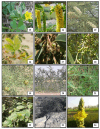Harnessing the application of halophytic flora biomass in the management of healthcare of local people in the Salt Range of Punjab
- PMID: 40467629
- PMCID: PMC12137565
- DOI: 10.1038/s41598-025-00961-z
Harnessing the application of halophytic flora biomass in the management of healthcare of local people in the Salt Range of Punjab
Abstract
The dependence of rural communities on salt-tolerant medicinal plants provides practical evidence of their utilization in healthcare systems in Salt ranges. Ethnomedicinal data were collected and documented by interrogating 138 local people and 13 traditional health practitioners using a visual appraisal approach, semi-structured interviews, rapid rural appraisal methods, and open-ended questionnaires, separately for each species and interviewee, in different localities of the Salt Range. Data was scrutinized quantitatively utilizing multiple quantitative indices, including frequency citation, use value (UV), informant consensus factor (ICF), and relative frequency of citation (RFC). The ethnomedicinal practices of 38 halophytes from 23 families were reported. Herbs (50%) were the leading life form. The findings reported Fabaceae as the dominant family with 5 species and Vachellia nilotica as a highly cited medicinal plant by respondents. Leaf (37%) was the most utilized plant fragment in herbal provisions, with 24 reports. Statistical analysis such as ICF exhibited a high value for the gastrointestinal disease category (0.62). The values of RFC and UV ranged from 0.22 to 0.48 and 0.08 to 0.7, respectively. Phytochemical evaluation indicates the strong pharmacological potential of these studied medicinal plants for drug development. Nageia wallichiana and Vachellia nilotica were threatened species and needed reclamation measures for their conservation. The sustainable utilization of medicinal flora requires proper conservation approaches because this is the primary healthcare source for rural communities in the Salt range. This study recommends sustainable ethnomedicinal utilization of Salt range flora and their conservation for an eco-friendly and green environment.
Keywords: Ethnomedicine; Medicinal flora; Phytochemistry; Salt range; Use value.
© 2025. The Author(s).
Conflict of interest statement
Declarations. Competing interests: The authors declare no competing interests.
Figures








Similar articles
-
Descriptive study of plant resources in the context of the ethnomedicinal relevance of indigenous flora: A case study from Toli Peer National Park, Azad Jammu and Kashmir, Pakistan.PLoS One. 2017 Feb 13;12(2):e0171896. doi: 10.1371/journal.pone.0171896. eCollection 2017. PLoS One. 2017. PMID: 28192466 Free PMC article.
-
Ethnobotanical and conservation studies of tree flora of Shiwalik mountainous range of District Bhimber Azad Jammu and Kashmir, Pakistan.PLoS One. 2022 Feb 7;17(2):e0262338. doi: 10.1371/journal.pone.0262338. eCollection 2022. PLoS One. 2022. Retraction in: PLoS One. 2023 Jun 14;18(6):e0287202. doi: 10.1371/journal.pone.0287202. PMID: 35130268 Free PMC article. Retracted.
-
Inventorization of some ayurvedic plants and their ethnomedicinal use in Kakrajhore forest area of West Bengal.J Ethnopharmacol. 2017 Feb 2;197:231-241. doi: 10.1016/j.jep.2016.08.014. Epub 2016 Aug 30. J Ethnopharmacol. 2017. PMID: 27590732
-
Ethnomedicinal and folklore inventory of wild plants used by rural communities of valley Samahni, District Bhimber Azad Jammu and Kashmir, Pakistan.PLoS One. 2021 Jan 13;16(1):e0243151. doi: 10.1371/journal.pone.0243151. eCollection 2021. PLoS One. 2021. Retraction in: PLoS One. 2023 Sep 5;18(9):e0291161. doi: 10.1371/journal.pone.0291161. PMID: 33439877 Free PMC article. Retracted.
-
Ethnobotanical study of medicinal plants used by the indigenous community of the western region of Mizoram, India.J Ethnobiol Ethnomed. 2024 Jan 3;20(1):2. doi: 10.1186/s13002-023-00642-z. J Ethnobiol Ethnomed. 2024. PMID: 38172927 Free PMC article.
References
-
- Dwivedi, A., Dwivedi, S. & Balakrishnan, B. R. Morphological and anatomical studies of the medicinal seeds of Abelmoschus Moschatus medik. Int. J. Pharm. Teach. Prac. 4 (3), 765–767 (2013).
-
- Mahmood, A., Mahmood, A., Malik, R. N. & Shinwari, Z. K. Indigenous knowledge of medicinal plants from Gujranwala district, Pakistan. J. Ethnopharmacol.148, 714–723 (2013). - PubMed
-
- Adzu, B., Amos, S., Amizan, M. B. & Gamaniel, K. Evaluation of the antidiar- rhoeal effectsof Zizyphus spina-christi stem barkinrats. Acta Trop.87, 245–250 (2003). - PubMed
MeSH terms
LinkOut - more resources
Full Text Sources

